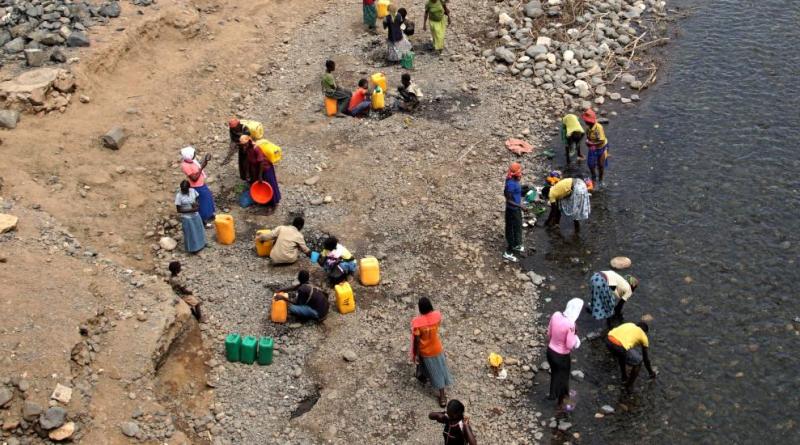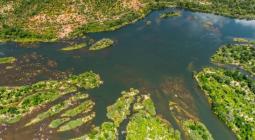The Situation is Poised to Worsen
By 2050, an additional 1 billion people are expected to live with extremely high water stress, even if the world limits global temperature rise to 1.3 degrees C to 2.4 degrees C (2.3 degrees F to 4.3 degrees F) by 2100, an optimistic scenario.
Global water demand is projected to increase by 20% to 25% by 2050, while the number of watersheds facing high year-to-year variability, or less predictable water supplies, is expected to increase by 19%. For the Middle East and North Africa, this means 100% of the population will live with extremely high water stress by 2050. That’s a problem not just for consumers and water-reliant industries, but for political stability. In Iran, for example, decades of poor water management and unsustainable water use for agriculture are already causing protests — tensions that will only intensify as water stress worsens.
Water Demand Is Exploding in Africa; Plateauing in Wealthier Nations
The biggest change in water demand between now and 2050 will occur in Sub-Saharan Africa. While most countries in Sub-Saharan Africa are not extremely water-stressed right now, demand is growing faster there than any other region in the world. By 2050, water demand in Sub-Saharan Africa is expected to skyrocket by 163% — 4 times the rate of change compared to Latin America, the second-highest region, which is expected to see a 43% increase in water demand.
This increase in water use, mainly expected for irrigation and domestic water supply, could foster major economic growth in Africa — projected to be the fastest-growing economic region in the world. However, inefficient water use and unsustainable water management also threatens to lower the region’s GDP by 6%.
Meanwhile, water demand has plateaued in wealthier countries in North America and Europe. Investment in water-use efficiency has helped reduce in-country water use in high income countries, but water use and dependencies extend beyond national boundaries, and the water embedded in international trade from lower-middle income countries to high income countries will increasingly contribute to rising water stress in low and lower-middle income countries.
Water Stress Could Majorly Disrupt Economies and Agricultural Production
Increasing water stress threatens countries’ economic growth as well as the world’s food security.
According to data from Aqueduct, 31% of global GDP — a whopping $70 trillion — will be exposed to high water stress by 2050, up from $15 trillion (24% of global GDP) in 2010. Just four countries — India, Mexico, Egypt and Turkey — account for over half of the exposed GDP in 2050.
Water shortages can lead to industrial interruptions, energy outages and agricultural production losses — like those already being seen in India, where a lack of water to cool thermal powerplants between 2017 and 2021 resulted in 8.2 terawatt-hours in lost energy – or enough electricity to power 1.5 million Indian households for five years. Failing to implement better water management policies could result in GDP losses in India, China and Central Asia of 7% to 12%, and 6% in much of Africa by 2050 according to the Global Commission on Adaptation.
Global food security is also at risk. Already, 60% of the world’s irrigated agriculture faces extremely high water stress — particularly sugarcane, wheat, rice and maize. Yet to feed a projected 10 billion people by 2050, the world will need to produce 56% more food calories than it did in 2010 — all while dealing with increasing water stress as well as climate-driven disasters like droughts and floods.
Better Management for a Water-secure Future
It’s good to understand the state of the world’s water supply and demand, but water stress doesn’t necessarily lead to water crisis. For example, places like Singapore and the U.S. city of Las Vegas prove that societies can thrive even under the most water-scarce conditions by employing techniques like removing water-thirsty grass, desalination, and wastewater treatment and reuse.
In fact, WRI research shows that solving global water challenges is cheaper than you might think, costing the world about 1% of GDP, or 29 cents per person, per day from 2015 to 2030. What’s missing is the political will and financial backing to make these cost-effective solutions a reality.
A few key ways to improve water management and reduce water stress include:
- Countries can improve their water governance, incentivize water efficiency in agriculture, adopt integrated water resource management, and enhance water infrastructure through nature-based solutions and green infrastructure. Protecting and restoring wetlands, mangroves and forests can not only improve water quality and build resilience against droughts and floods, but also save money on water treatment costs.
- International development banks and other lenders should consider strategic debt relief programs, like debt-for-nature swaps, or debt relief in return for a commitment to invest in biodiversity or resilient infrastructure, such as mangrove restoration or wetland conservation. These nature-based solutions can achieve positive climate and water outcomes in countries unable to afford improved water management on their own.
- Policymakers in water-stressed countries should prioritize water-prudent energy sources like solar and wind to avoid power shutdowns caused by water shortages.
- Cities should develop urban water resilience action plans, learning from the group of six African cities already piloting such approaches. Treating and reusing wastewater could also create new water sources for cities.
- Farmers should use more efficient water measures, such as switching to water-efficient crops or using methods like sprinkler or drip irrigation versus flooding fields.
- Companies should set science-based water targets, which are in line with what the science says is “enough” to stay within Earth’s limits and meet society’s needs, learning from a growing number of businesses that have already set such targets.
Every level of government, as well as communities and businesses, must step up to build a water-secure future for all. The world will ultimately require an all-of-the-above approach, as well as solutions specific to individual catchments and regions.
These findings may be daunting, but with the right management, every country can prevent water stress from turning into water crisis.







